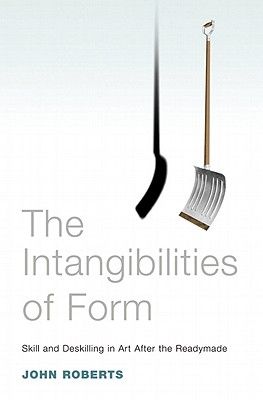Currently Reading: John Roberts. 2007. The Intangibilities of Form: Skill and Deskilling After the Readymade. Versus, London, UK. Preface & Introduction. Spring 2011. Variant 41, pp.43-7.
http://www.variant.org.uk/41texts/jroberts41.html
Roberts analyses the skill and labour of post-1960s conceptual art and raises the issue of authorship in relation to these dynamics of art commodity production. He asserts that there is much intellectual confusion about what constitutes skill in art after the readymade.
Handicraft and associated skills in the production of art are historically accepted as a gauge of authorship. With the introduction of the readymade, the notion that the artist as author must be considered under other conditions of production; where handicraft executed by the artist is no longer the primary criteria.
The notion of the artist’s handicraft, once pivotal to the question authorship, is regularly negated in works involving waste materials. Pre-used, readymade objects may have been shaped and given social history at the hands of anyone. Objects that are ordinarily used and discarded require no specialised handicraft to render them waste. Sometimes artists reintroduce handicraft into the treatment of waste materials in art production, but in the case of objects rendered rubbish at the hand of the artist as art production, the concept of anti-craft is suggested; positioning the artist on an equal level with the viewer in terms of object production.
Roberts is keen to point out that the hand of the artist is not limited to handicraft and stresses the importance of the “emergent totipotentiality or multifunctionality of the hand in artistic labour.”
Rubbish utilised in art is a type of readymade in the sense of being “an ordinary object elevated to the dignity of a work of art by the mere choice of an artist”(1). Rubbish is very ordinary, but perhaps demands more of an elevation than the object with use-value or exchange-value. Rubbish has depleted its value, so the elevation to status of art could be considered a short-circuiting of this value system. This production of new function; the recycling of rubbish into art, creates new value where previously there was little or none, and, in a sense, is productive labour at its maximum in creating commodity from rubbish.
As well as considering Marx’s distinctions between productive and non-productive labour in the denotion of function and use-value of art, Roberts also distinguishes between intellectual labour and manual labour in discussing the readymade. “Modern artists are encouraged to think of themselves as active as artists beyond the ‘limited’ point of production, because, it is claimed, artists need to think of themselves as directly engaged in the mediation of the meanings of their work.”
The artist-as-producer, or author-as-producer as Benjamin writes(2), takes an active, exemplary and politicised position on their work from within and in response to the socio-political framework in which it was created. These are ideal conditions for autonomous authorship in the production of art. Skill and artistic labour, therefore, are no longer limited to commodity production exclusive of context, but rather must be considered in entirety of the interventions that render the readymade as art commodity.
This division between intellectual and manual labour and emphasis on context-specificity might position intellectual processes above manual processes in an artistic skills hierarchy. Processing rubbish in artworks often requires low levels of manual skill, although many exceptions do exist, and the artists’ skills are often found in the intellectual reconfiguration or recontextualisation of the objects. Perhaps this scenario is best seen in sculpture and assemblage in tradition of the readymade, as opposed to, say, photography and video where skill lies somewhere in the realm of manual labour but now more often than not in digital form.
If intellectual intervention supersedes manual labour in the treatment of rubbish as readymade in the production of art, can manual labour still play a part in the role of the artist, that is not delegated to assistants for example? I would argue that when artists do employ manual skills in art production, they do so consciously in an intellectual framework that acknowledges the histories and traditions of such skills in order to draw attention to the nature of manual labour itself and specific modes of production.
–
(1) Definition of the readymade. Breton, André and Éluard, Paul. 1991. Dictionnaire abrégé du Surréalisme
(2) Benjamin, Walter. 1934. The Author as Producer.



